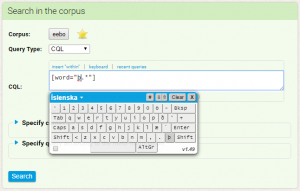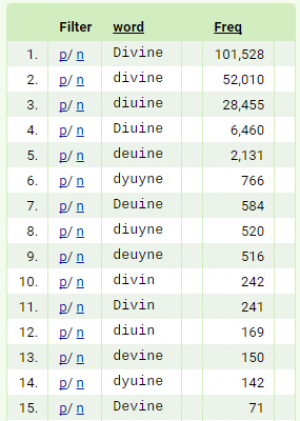Table of Contents
Lesson 2: Orthography and Spelling
The period covered by the EEBO corpus (roughly 1400-1700) is one in which spelling was not as stable as it is in the present day. As a result of this, one word could have a number of forms, and it is necessary to keep this in mind when conducting a corpus search. For example, the word love also appeared with <u>, as in loue, but its other variants include leoue, lowe, lowfe and lovue. When searching for a specific lexical item, it is always advisable to consult a reliable source, such as OED Online, for all the possible forms (spelling variants) available in the given period.
Special symbols
Although the orthography of Early Modern English is very similar to that which we use today, there are several letters, mostly from Old English, which are no longer in use in Present day English.
- the long <ſ>, which was a variant of the short <s>, could appear anywhere in a word except in the final position, for example in moſt (most), notwithſtandyng (notwithstanding), firſt (first), Chriſt (Christ), oppreſſed (oppressed)
- the runic letter “thorn” < þ>, representing the dental fricative, was a possible alternation of the digraph <th>, for example þaet (that). It is still present in the modern Icelandic alphabet and therefore accessible via the inbuilt Icelandic keyboard in Kontext (Íslenska).
- representing the open front vowel is the letter “ash” <æ>, also available on the Icelandic keyboard (Íslenska)
The Icelandic keyboard contains the symbols for “thorn” and “ash” which we may need especially when searching in older sections of the corpus in KonText:
Spelling
| feature | description |
|---|---|
| <v>, <u> and <w> | there was no distinction between <v> and <u>, and occasionally <w>; they were variants of a single letter, for example in vntill (until), euill (evil), giue vp (give up), brawe (brave) |
| <y> and <i> | the letters <y> and <i> were frequently interchanged to represent the close front vowel [i], such as rayne (rain) |
| <i> and <j> | apart from representing the close front vowel , <i> also functioned as a variant of the consonant letter <j>, hence the forms ielous (jealous) and iust (just) |
| double consonants | doubling of consonants was common when preceded by short vowel, for example in chinnes (chins), eternall (eternal), bagge (bag – the vowel was still short in Early Modern English) |
| <y> and <þ> | <y> could also represent the dental fricative, which had previously been written with the runic symbol thorn <þ>, for example ye olde folk (the old folk) |
| silent <e> | the silent <e> at the end of words, usually marking a preceding long vowel, but also sometimes appearing as a relic of inflectional suffixes, found for example in plucke (pluck), speake (speak), feare (fear) |
There are many other, albeit minor, categories of formal variation, for example:
- the elision of certain letters, for example in suffred (suffered)
- length in hée (he), séemeth (seems)
- the letter <o> frequently represented the sound which we often write as <u>, for example ſommer (summer)
- the postalveolar fricative [ʃ] (the initial sound in shoe) was occasionally represented by the letter <c>, such as in nacions (nations),
- the syllable < -ic> was often spelt < -ick>, such as in publick (public)
As a result, we are faced with forms such as vnleſſe (unless), punniſhing (punishing) and lykewyſe (likewise)
Searching the corpus
If searching simply for one particular form, we may use the basic query as described in our first lesson .
However, in order to secure as many permutations as possible, the query can be written in CQL (Corpus Query Language) using a number of regular expressions. Furthermore, the CQL query mode in the KonText interface is case sensitive, and therefore both variants should be included in the query in order for us to obtain as many relevant hits as possible.
For example searching for the two forms love and loue simultaneously requires use of the vertical bar |, which is a regular expression functioning as “or”, i.e. it returns either love or loue
[word=“love”]|[word=“loue”]
Keeping in mind that CQL is case-sensitive, and so it is necessary to add the forms with capital letters. When another pair of square brackets [] is inserted into those which delimit the “word”, the items within those square brackets form a set from which only one is selected. Therefore the forms Love, Loue, love and loue are all contained in the following query:
[word=“[Ll]o[vu]e”]
Say that we would like to add the variant lov (also a legitimate ME/EModE variant) to our four forms. For this operation, we may use another regular expression, the question mark ?, which indicates that the element directly preceding it is optional. With this symbol, there is no need to add [word=“[Ll]ov”] - the query can be simplified thus:
[word=“[Ll]o[vu]e?”]
Question: We want to find all possible forms of the lexical item divine. How should the query be written in order to return as many variants as possible?
After consulting an etymological dictionary and also based on our previous experience, we know that we may expect forms such as diuine, deuine, dywine, and divinne (among many others). The vowel can be either e, i or y, which is simplified as [eiy]. The same is true of the set [uvw]. The form always contains at least one nasal n, while the second is only optional (indicated by the question mark). The final silent e is also optional. The resulting query should look like this:
[word=“[dD][eiy][uvw][iy]nn?e?”]
Frequency → Node forms provides a list of all types found with the given query in order of their frequency.
A similar example is with the word godly:
Godly: [word=“[gG]oo?dle?[yi]c?k?e?”]
This query returns not only the frequent forms godly, goodly, godlie, godlye and goodlye, but also much less frequent (and much less anticipated) variants such as godlyc and even godlycke. In the latter we can observe remnants of the Old English adjectival suffixes ←līc> and ←līce>.
Task: Spelling variants
- Find as many spelling variants of the word royal as possible
- Keep in mind the spelling conventions and irregularities mentioned above
- Make sure that the Query type is set to CQL
If you are ready, you can continue to Lesson 3.









